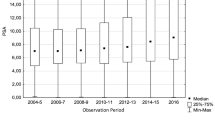Abstract
Background
Patients with advanced local-stage, high-grade prostate cancer (Pca) and high pretreatment prostate-specific antigen (PSA) levels have inferior outcomes compared to their counterparts with more favorable clinical characteristics. However, some patients exhibit favorable pathological features or experience long-term PSA-free survival after radical prostatectomy (RP). We retrospectively examined the ability of preoperative characteristics to predict pathological and oncological outcomes in high-risk Pca patients who underwent RP.
Methods
We examined data of 1,268 consecutive Pca patients treated with RP alone at 4 hospitals from the Michinoku Urological Cancer Study Group database. Preoperative predictors included age, PSA level, biopsy Gleason score, clinical T stage, and PSA density (PSAD). The outcome measures pathological T stage and PSA-free survival were evaluated by multivariate analysis.
Results
We identified 380 high-risk Pca patients, of which 44 % patients had extracapsular extension. Logistic regression analysis indicated that PSAD was an independent predictor of adverse pathologic stage. The 5-year PSA-free survival rates were 82.9 % for patients with PSAD ≤0.468 ng mL−1 cm−2 and 50.7 % for those with PSAD >0.468 ng mL−1 cm−2 (P < 0.0001). Multivariate analyses revealed that PSAD, cT, and the number of preoperative high-risk Pca criteria were independent predictors of PSA-free survival.
Conclusions
PSAD may be an independent predictor of advanced pathological features and biochemical recurrence in high-risk Pca patients treated with RP alone. PSAD may be used for further risk stratification of high-risk Pca patients.




Similar content being viewed by others
References
D’Amico AV, Whittington R, Malkowicz SB et al (1998) Biochemical outcome after radical prostatectomy, external beam radiation therapy, or interstitial radiation therapy for clinically localized prostate cancer. JAMA 280:969–974
Yuh B, Artibani W, Heidenreich et al (2013) The role of robot-assisted radical prostatectomy and pelvic lymph node dissection in the management of high-risk prostate cancer: a systematic review. Eur Urol. doi:10.1016/j.eururo.2013.05.026
Loeb S, Schaeffer EM, Trock BJ et al (2010) What are the outcomes of radical prostatectomy for high-risk prostate cancer? Urology 76:710–714
Sundi D, Wang V, Pierorazio PM et al (2014) Identification of men with the highest risk of early disease recurrence after radical prostatectomy. Prostate. doi:10.1002/pros.22780
Polascik TJ, Oesterling JE, Partin AW (1999) Prostate specific antigen: a decade of discovery-what have learned and where we are going. J Urol 162:293–306
Horiguchi A, Nakashima J, Horiguchi Y et al (2003) Prediction of extraprostatic cancer by prostate specific antigen density, endorectal MRI, and biopsy Gleason score in clinically localized prostate cancer. Prostate 56:23–29
Brassell SA, Kao T, Sun L et al (2005) Prostate-specific antigen versus prostate-specific antigen density as predictor of tumor volume, margin status, pathologic stage, and biochemical recurrence of prostate cancer. Urology 66:1229–1233
Corn BW, Hanks GE, Lee WR et al (1995) Prostate specific antigen density is not an independent predictor of response for prostate cancer treated by conformal radiotherapy. J Urol 153:1855–1859
American Joint Committee on Cancer (AJC) (2010) Prostate. In: Edge SB, Byrd DR, Compton CC et al (eds) AJCC cancer staging manual, 7th edn. Springer, New York, pp 457–468
Epstein JI, Allsbrook WC Jr, Amin MB et al (2005) The 2005 International Society of Urological Pathology (ISUP) consensus conference on Gleason grading of prostatic carcinoma. Am J Surg Pathol 29:1228–1242
Gancarczyk KJ, Wu H, McLeod DG et al (2003) Using the percentage of biopsy cores positive for cancer, pretreatment PSA, and highest biopsy Gleason sum to predict pathologic stage after radical prostatectomy: the Center for Prostate Disease Research nomograms. Urology 61:589–595
Perkins NJ, Schisterman EF (2006) The inconsistency of ‘optimal’ cutpoints obtained using two criteria based on the receiver operating characteristics curve. Am J Epidemiol 163:670–675
Boorjian SA, Karnes RJ, Rangel LJ et al (2008) Mayo clinic validation of the D’Amico risk group classification for predicting survival following radical prostatectomy. J Urol 179:1354–1361
Ishida M, Nakashima J, Hashiguchi A et al (2009) Are predictive models for cancer volume clinically useful in localized prostate cancer? Int J Urol 16:936–940
Lee JT, Lee S, Yun CJ et al (2010) Prediction of perineural invasion and its prognostic value in patients with prostate cancer. Korean J Urol 51:745–751
Pierorazio PM, Guzzo TJ, Han M et al (2010) Long-term survival after radical prostatectomy for men with high Gleason sum in pathologic specimen. Urology 76:715–721
Koie T, Hashimoto Y, Hatakeyama S et al (2011) Minimum incision endoscopic radical prostatectomy: clinical and oncological outcomes at a single institute. Eur J Surg Oncol 37:805–810
Tsuzuki T, Hernandez DJ, Aydin H et al (2005) Prediction of extraprostatic extension in the neurovascular bundle based on prostate needle biopsy pathology, serum prostate specific antigen and digital rectal examination. J Urol 173:450–453
Perotti M, Pantuck A, Rabbani F et al (1999) Review of staging modalities in clinically localized prostate cancer. Urology 54:208–214
Radwan MH, Yan Y, Luly JR et al (2007) Prostate-specific antigen density predicts adverse pathology and increased risk of biochemical failure. Urology 69:1121–1127
Giannarini G, Scott CA, Moro U et al (2008) Are PSA density and PSA density of the transition zone more accurate than PSA in predicting the pathological stage of clinical localized prostate cancer? Urol Oncol 26:353–360
Conflict of interest
No author has any conflict of interest.
Author information
Authors and Affiliations
Corresponding author
About this article
Cite this article
Koie, T., Mitsuzuka, K., Yoneyama, T. et al. Prostate-specific antigen density predicts extracapsular extension and increased risk of biochemical recurrence in patients with high-risk prostate cancer who underwent radical prostatectomy. Int J Clin Oncol 20, 176–181 (2015). https://doi.org/10.1007/s10147-014-0696-0
Received:
Accepted:
Published:
Issue Date:
DOI: https://doi.org/10.1007/s10147-014-0696-0




